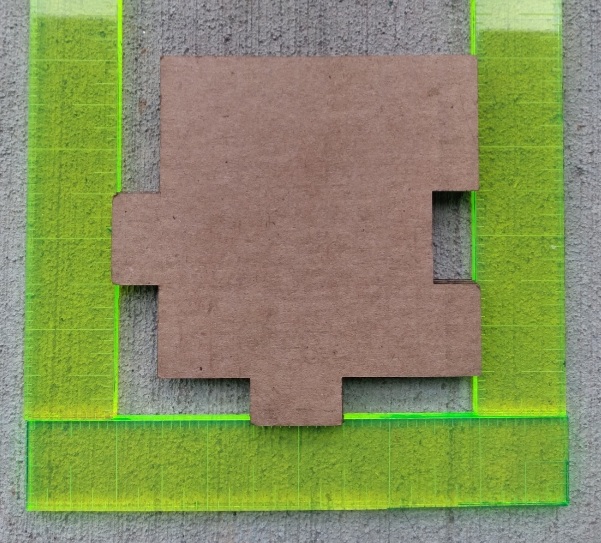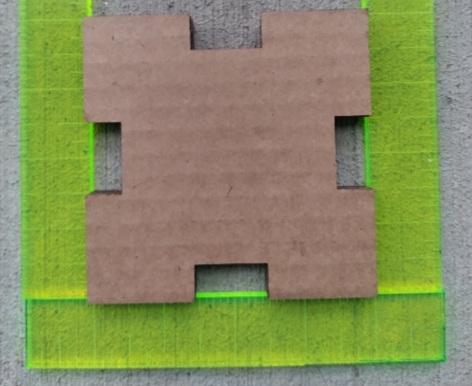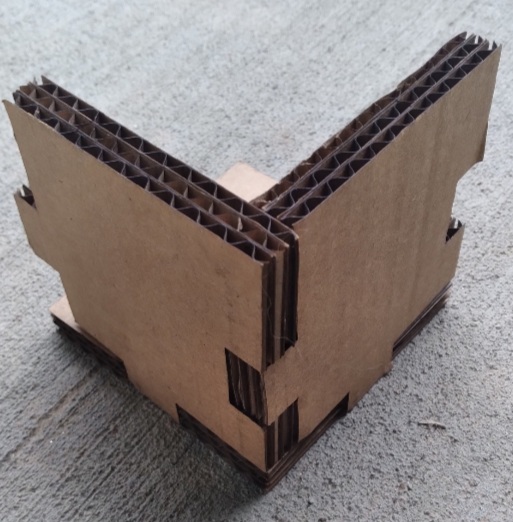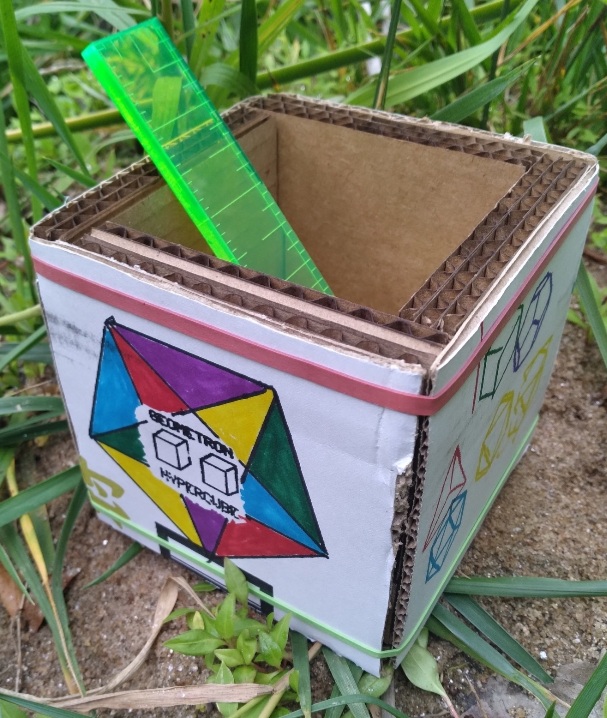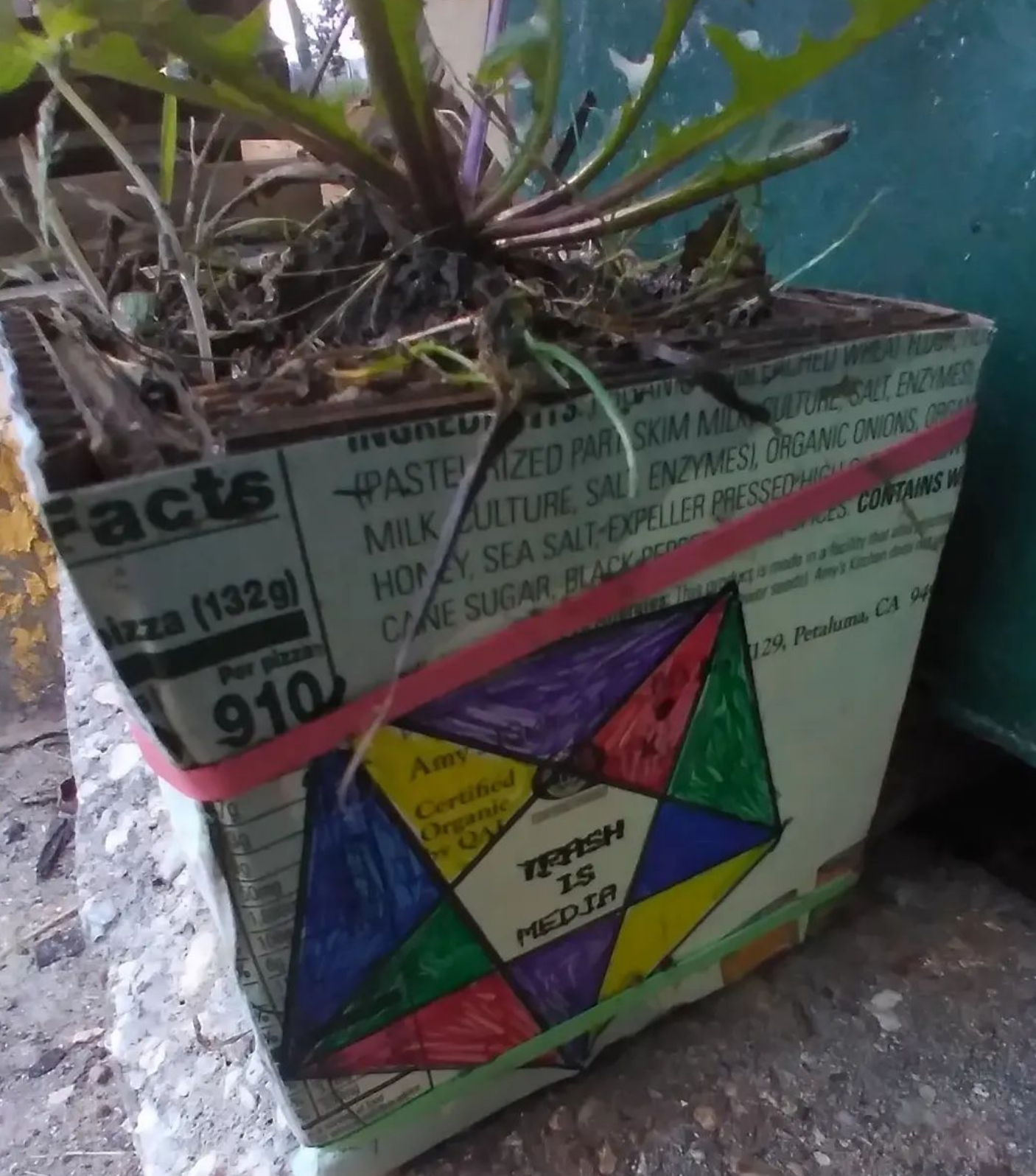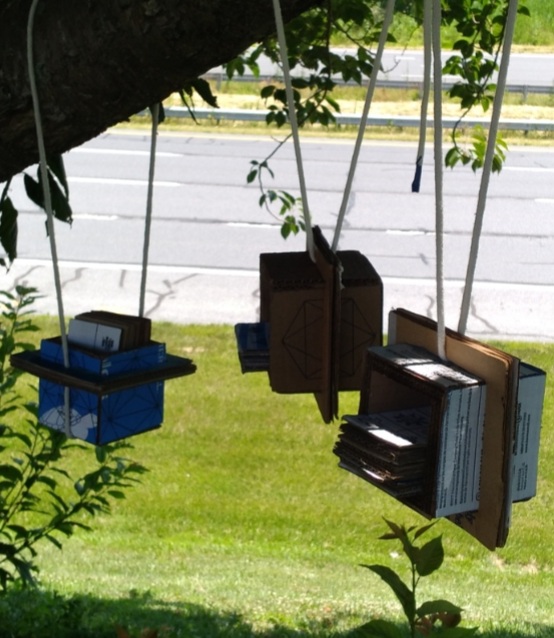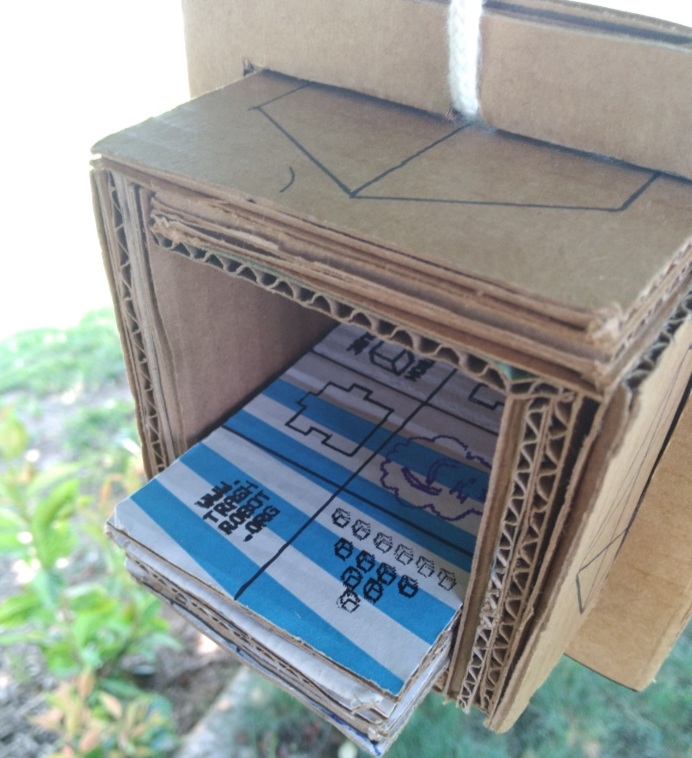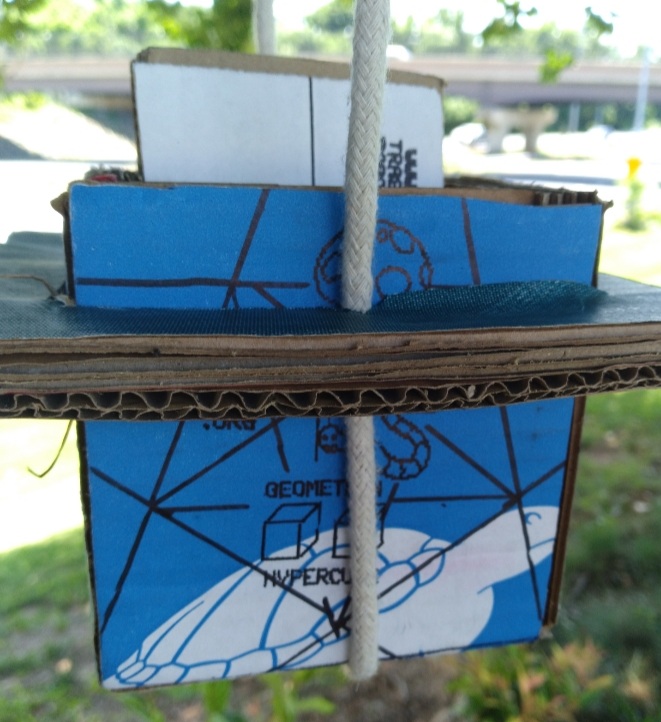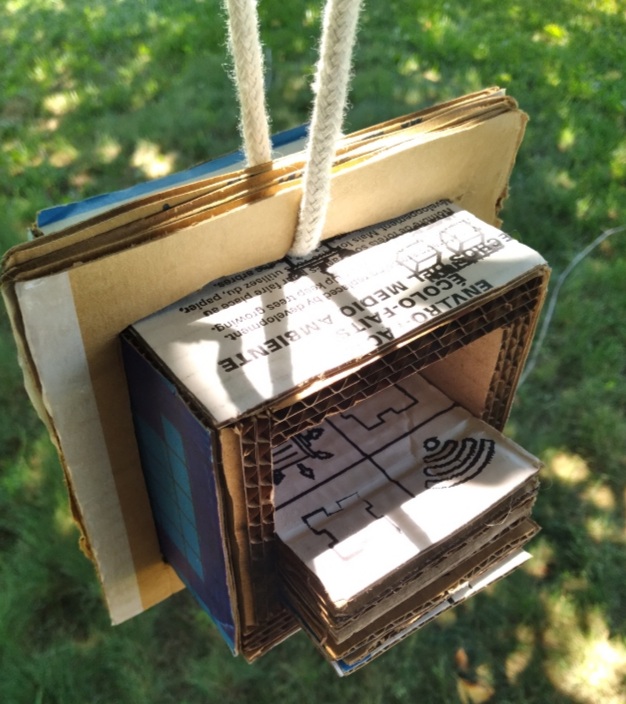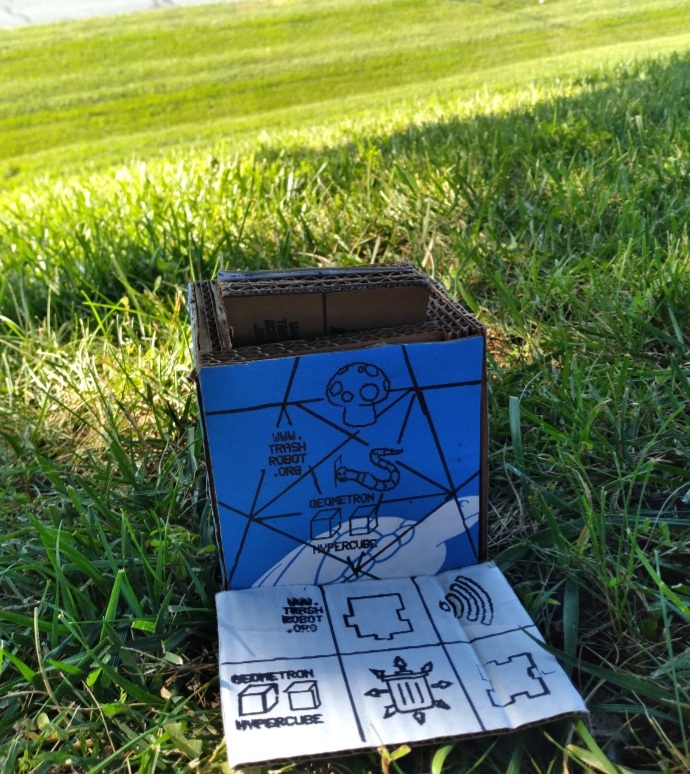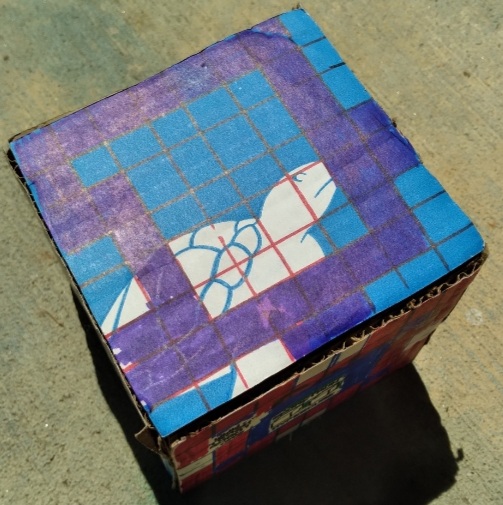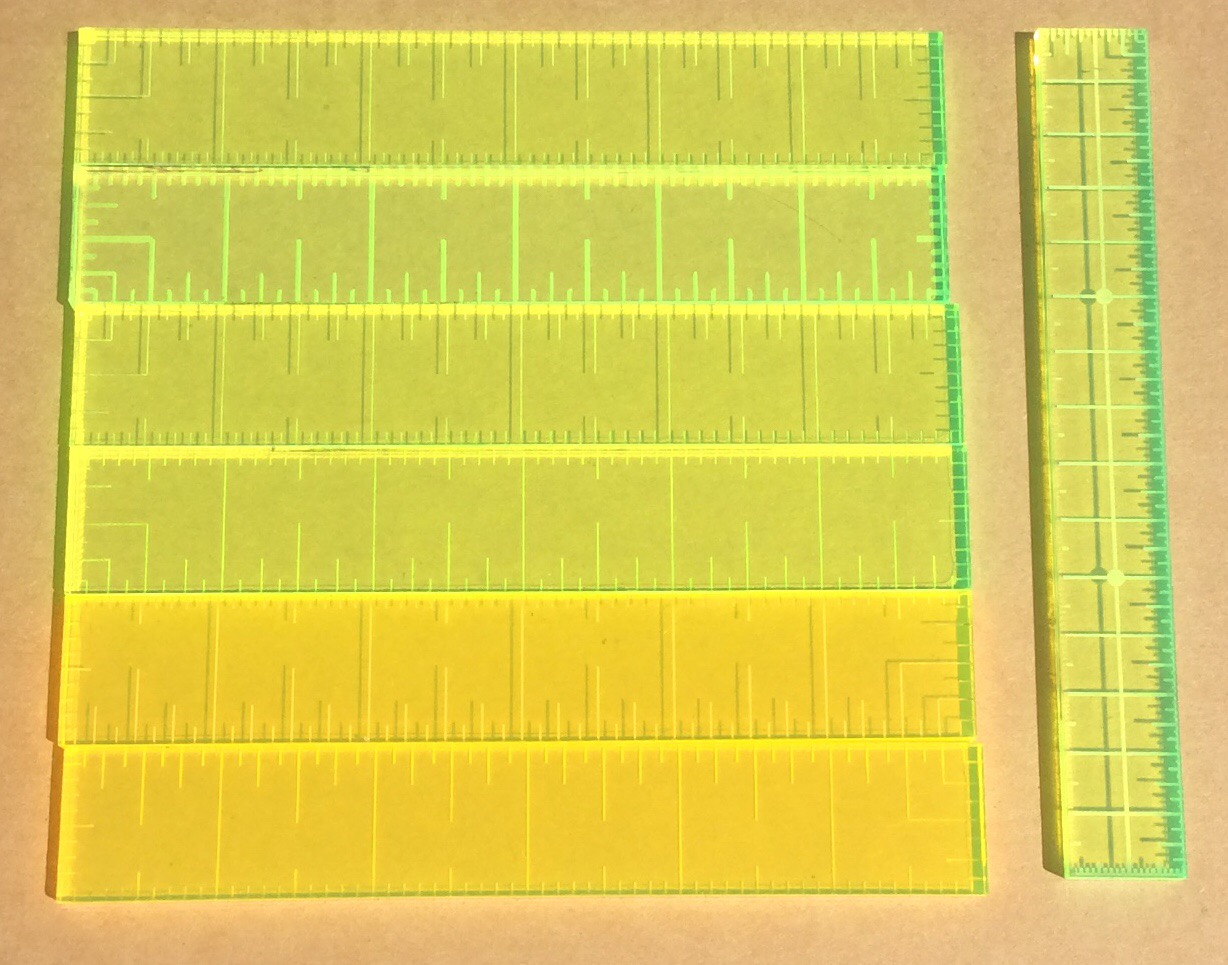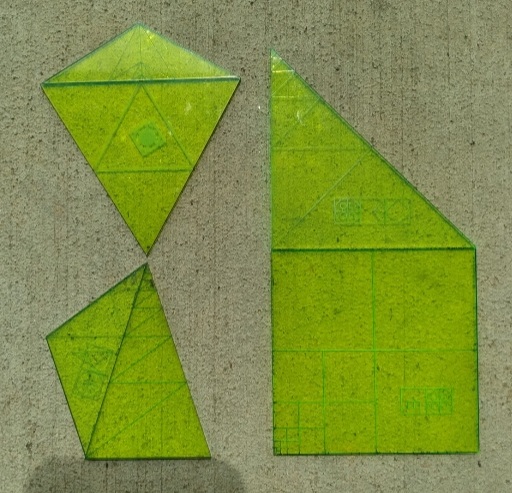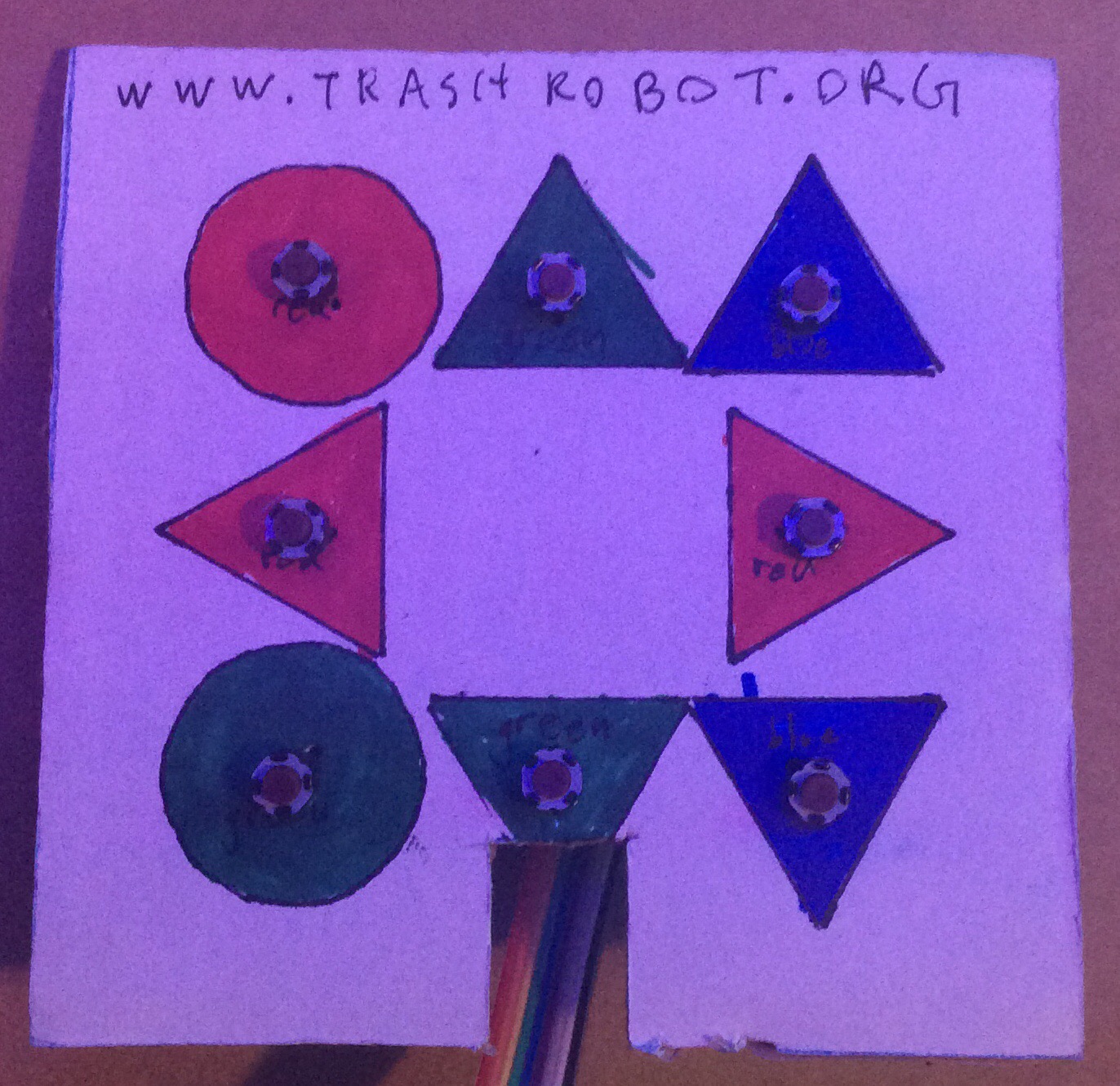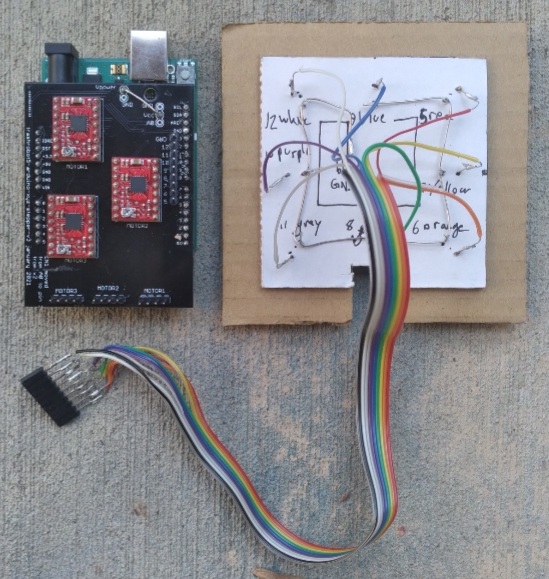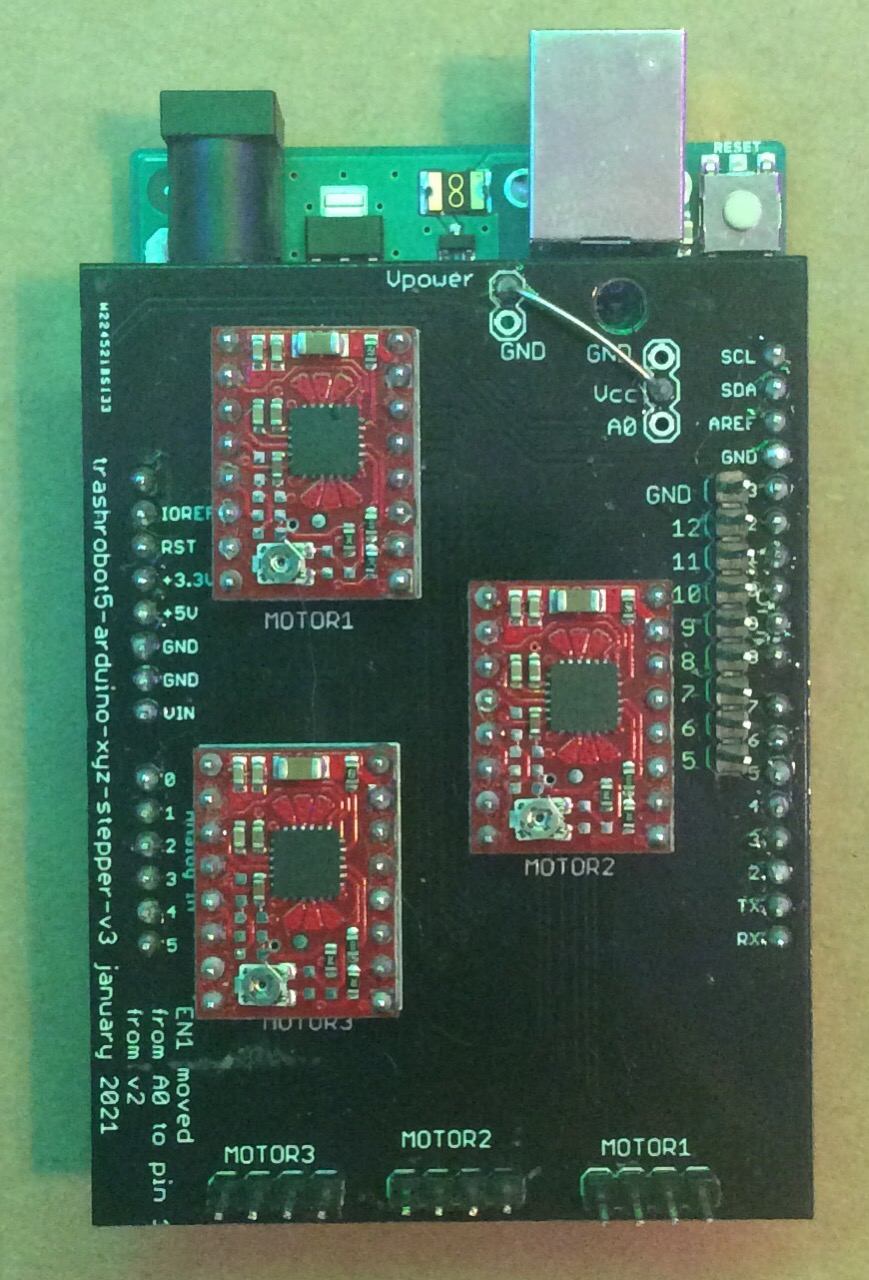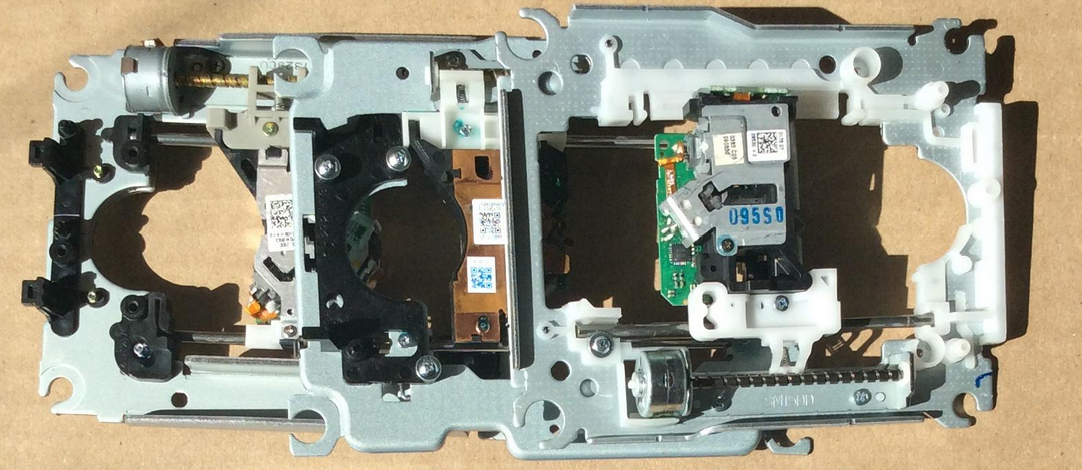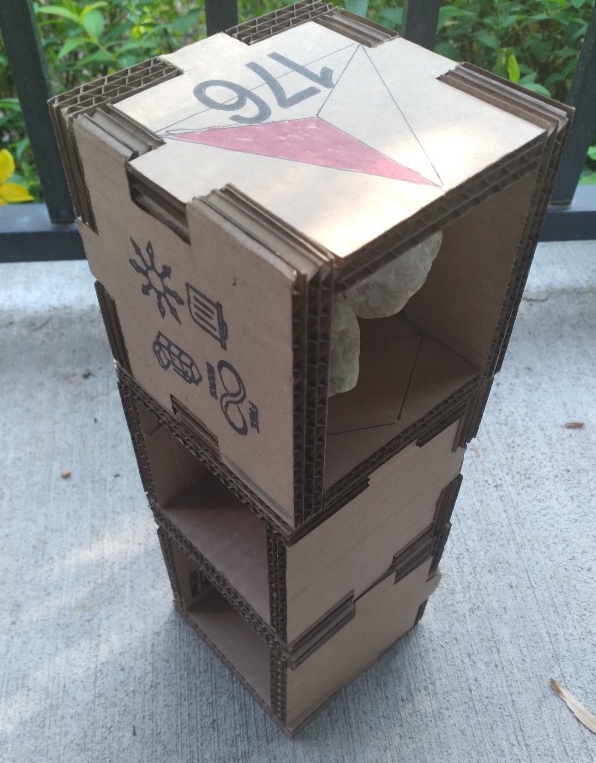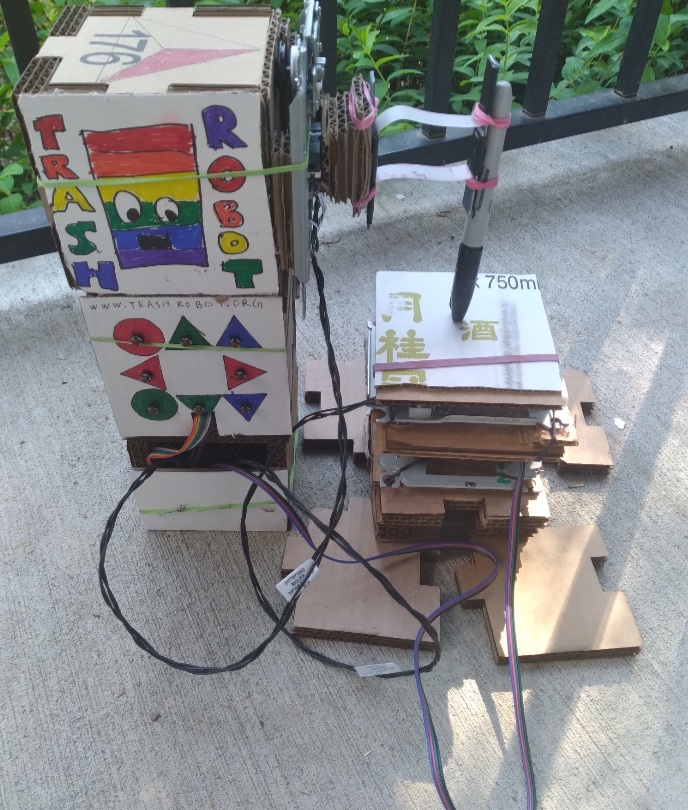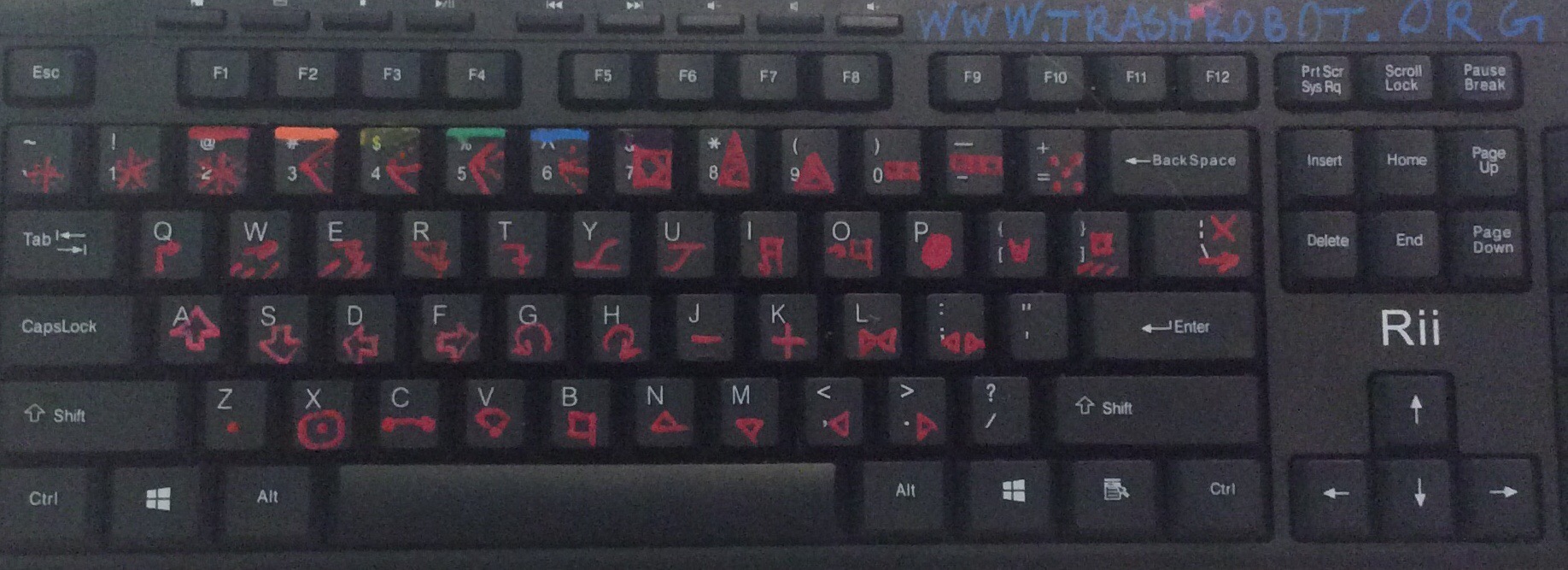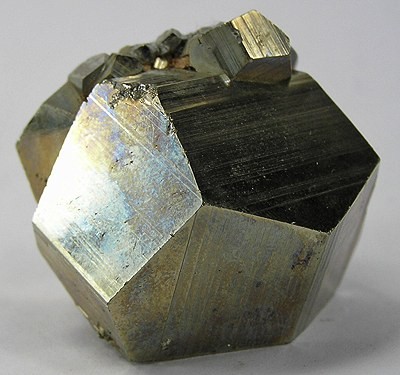Trash Magic self-replicating media which propagates the means of building a civilization entirely from trash and things we can grow.
The Geometron Hypercube is two things: The set of all of the 4 inch cubes we make from cardboard trash which are the basis of our physical technology and a geometric language based on the fundamental symmetries of the Universe. We construct both of these things in order to make it easier to build Trash Magic, using the power of geometry to build things which can be easily replicated and which can build a very wide range of useful objects. The word "hypercube" here is used to represent generalizations of the cube into higher dimensions in a broad sense. We take this to mean a set containing many different cubes of many different kinds.
The cube is 4 inches on a side and can be used for:
- pencil/rulers/pens/brushes/shapes box
- marketing display
- card box for Geometron Trash Magic Cards
- mushroom farms
- worm farms
- link to oyster mushroom cardboard farming
- buy worms to farm in compost bins
- tiny compost piles
- plants, seedlings
- dice
- parts bins
- motion sense control pyramids
- motor fixture
- geometron icon printer tower
- large collaborative art structures
- lamps
tiktok of hand cut cube without a laser
To make one cube, cut out 12 of these from corrugated cardboard, stack them into four panels 3 layers thick and glue them using Elmer's glue:
.svg file for laser cutter:
Now cut out 3 of the bottom pieces, and stack them into a fifth glued panel.
.svg file for laser cutter:
Assemble the sides into the base as shown:
Cut out 4 inch squares, print on them, glue them to the panels, and hold it all together with rubber bands:
Every cube we produce in the Trash Robot Network is part of the Geometron Hypercube. Therefore to grow the Hypercube, we produce and distribute as many cubes as we can, and always evolve the cubes to make them better over time and to solve specific problems to bring us closer to Trash Magic.
To make geometric constructions out of cardboard trash, we use the tools of Action Geometry, which are created with the Geometron Language. These include the ruler, which we cut from 0.2 or 0.25 inch thick neon green acrylic and the shape sets which we cut from 0.1 or 0.125 inch thick neon green acrylic.
The Geometron Ruler is one inch by six inches. One side has tenths and the other halves, quarters and eights. The highest quality rulers are made from quarter inch neon green acrylic with a laser cutter. Any ruler can be used to make more rulers. Cereal box cardboard is a good material. Find a maker space or individual with a laser cutter. Dig through the waste bin to find extra acrylic. Place the outlines and etch and make rulers. Give them away and spread the word of Geometron, Trash Magic, Trash Robot and so on. Also you can use Ponoko.com to get large numbers of rulers made and can sell those if you so choose.
Using Ponoko.com is only cost effective if you have a budget of over 1000 dollars, then the cost per ruler can drop to about a dollar and a half. Also, Ponoko only has eighth inch acrylic and quarter inch is the nicest. For best results, go find 0.2 inch or quarter inch neon green acrylic somewhere, find a laser cutter and print these out yourself. All the files for this are below.
This is some 6 inch rulers from both green and yellow acrylic and a 15 cm metric ruler.
Ruler Outline SVG file:
Ruler Etch pattern PNG file:
Ruler 2 color SVG file for Ponoko.com:
Set of 8 rulers in one SVG file for Ponoko.com:
Centimeters PNG file for etch. Print out with 15 centimeter width and 2 cm height:
centimeters Ruler Outline SVG file, line up with etch and make 15x2 cm:
One ruler with etch and cut in different layers:
Set of 8 cm rulers in one SVG file for Ponoko.com:
These shapes are used for constructions based on fundamental symmetries: fourfold, eightfold, threefold, fivefold, and sixfold. For best results, we cut them out from eight inch neon green acrylic with a laser cutter.
.svg file for use in laser cutter. Each shape has side of 3 inches, so this is a 6 inch wide file:
These can all also be constructed using the tools of classical geometry(compass and ruler) or a ruler and a protractor. So they can be made by hand and cut out from cardboard or paper trash if no laser or acrylic is available.
- link to program the Arduino UNO in the Printer Robot
- link to global image feed
- link to image aligner
- link to icon tracer
- link to icon set
- 3 motor controller boards from Pololu(10x3=$30)
- Custom printed circuit board to connect Arduino to controllers and connectors($2/ea in lots of 20 with shipping)
- straight 0.1 inch headers from Digikey(buy about 2 per kit at about 60 cents each)
- Ribbon cable from Digikey(about $8 for about 6 kits worth for about $2/kit rounding up )
- 8 buttons for controller from Digikey(about $1 for all 8)
- Cables from Digikey to connect stepper motors in DVD drive stages to circuit board(about $10 for 3 of them)
- Arduino Uno from Sparkfun($25, some off brand UNOs have power supply problems for this application, test any new board to see if it stalls out)
- 9 pin socket headers
Two each of a 0.5 inch by 4 inch thin HDPE sheet and two 0.5 inches by 3 inches thick stiffer plastic. All held on by rubber bands as shown, as well as attached to the Z stage.
- hole in the bottom of box image with ruler position
- eagle files
- link to buy
- list of components
- digikey shopping cart
- photo of assembly for neopixel
- photo of assembly for sense pyramid
- sense pyramid photo
- sense pyramid triangles
- link to neopixel code
- link to github repo
- link to pyramids 3 sense code
- photo of rotor setup
- 200 W solar panel
- lead acid battery power plant with weather protection
- 12x8 inch laser cutter with 40 or 50 W CO2 laser, converted to geometron operation
- independent suspension and weather protection for laser cutter
- power output: 12 volt regulated, USB chargers, inverter for AC wall power
- power input: solar panels, wall charge, car charge, bicycle charger, wind, water
- Raspberry Pi Geometron Server with the whole system from https://github.com/LafeLabs/hypercube
- setup for pi with small screen, projector, portable screen for projector, geometron keyboard(s), mouse, USB thumb drive to get files onto pi crust
- neopixel strips lighting up the whole system
- arduino shields for neopixel, pyramids, motors, robots, etc, arduino setups, boards
- cube stack: lots of cubes of all kinds: card boxes, art boxes, parts boxes, planters with plants, fungi, compost, empties, parts to make more
- fully set up geometron icon printer to print on cards, cubes, and trash
- hanging green wall of plants
- tarp, awning for getting out of rain
- folding chair to sit under awning
- neon green acrylic shape sets and rulers
- router to connect to mesh network or cell network and make a wifi hotspot
Geometron is a language for creating geometric constructions using these symmetries. We aim to build the most powerful possible interface between the human mind and the physical world. To do this we build geometric actions based on the fundamental symmetries of the Universe. We represent those actions using symbols we construct using that same set of actions. We describe each of the geometric actions using a human language we understand, with phrases like "draw a unit circle", while also creating symbols which are used in the language to express itself.
Geometron is constructed independent of any one physical technology to implement it, or any one set of symbols. It is a means of creating symbolic geometric languages. The Geometron Hypercube elements which make up the language are an arrangement of geometric actions into cubes. One cube contains all the actions which are not explicitly symbols, and the other cube represents all the symbols for the actions in the action cube. Each cube is broken up into a crystal of 8 by 8 by 8 cubes. Each of those cubes contains a sequence of cube addresses, which are geometric actions. Thus the Geometron Hypercube is a model for constructing geometric and symbolic languages which we can build up by hand using pencil and paper, and then implement in any computer language relatively quickly.
A Geometron Glyph is a sequence of these geometric actions which are represented by addresses in the Hypercube. These glyphs are abstractions which can be expressed as sequences of symbols in any format(a browser, a pen and paper, a printer or plotter) but which can apply to any kind of physical construction. This might include movements of motors in robotic machines which carry out automation of production, like laser cutters, electron beam writing tools, milling tools or 3d printer heads. Or it might include lighting up pixels on a screen or deflecting the beam of a cathode ray tube.
Addresses in the Hypercube all begin with "0" to indicate that they are base 8(digits are all between 0 and 7). All addresses in the symbol cube have a "1" added. The Action cube is divided by types of operation into tablets, which are each arrays of 8x8 = 64 actions which can be arranged in a square on a chess board. The planar operations which are used to construct symbols on computers are all in the range from 0300 to 0377(with matching symbols at 01300 to 01377). The actions in the range from 0200 to 0277(with matching symbols at 01200 to 01277) are all sequences of either planar actions in the 03xy range or other actions in the 02xy range. Thus we can build up complex structures which call other sub-structures. This is of critical value for design of technology, as we can create complex systems of systems built up from very simple components in a fractal way. Addresses in the range from 040 to 0176 correspond to the ASCII codes for the characters which can be printed and have a symbol on standard US keyboards. Fonts in English are stored as sequences of actions in the range from 01040 to 01176. The contents of each of the ASCII addresses are actions which are triggered when that key is pressed. This mapping is what is represented physically in the custom painted Geometron keyboards we build.
We assign keys on physical keyboards to symbols which represent actions in order to make it easier to interact with Geometron on a keyboard. We make these with paint pens, pain brushes, nail polish, stickers, or any other means of decorating keyboards as follows:
These are edited on a Geometron server using the keyboard editing page linked from the main symbol editor.
We can use Geometron to create symbolic languages made up of shapes which can be called using their own symbols. These can be used to create things like the Action Geometry shapes, electronic schematic diagrams, logic gates, chemical diagrams, architectural diagrams, illustrations, and really any kind of symbolic language including for technology design like circuit layout for fabrication.
Some examples of constructions using shape sets
Fonts correspond to the addresses in the symbol cube which map to the key actions in the action cube. I.e. the address is the ASCII value plus 01000 base 8.
Dot Matrix Font:
Laser cut font:
Katakana dot matrix font:
Symmetries are properties of things which remain the same under geometric transformation. The Universe as we find it displays certain symmetries again and again in both the living and non living world. Perhaps the most fundamental of these are crystal lattices, where movement in certain directions by certain distances leads to a repeating of patterns. Perhaps the next most common symmetries we see in Nature are those of certain special rotations: bilateral symmetry, trilateral symmetry, fourfold, fivefold, sixfold, eightfold, tenfold, and twelvefold.
Each of these special rotational symmetries has certain scales which are built into them. When we work with squares and octagons, we find the square root of two and two coming up again and again in 45 degree angle constructions. When we work with hexagons and equilateral triangles, we get scales by the square root of three, three, and two. And finally anything with fivefold symmetry has the Golden Ratio built into its construction.
Movement by one unit, just moving from point to point:
Repeated movements can create crystal lattices, like the checkerboard pattern:
A circle is totally symmetric around rotations:
Bilateral symmetry is particularly common in living things:
Threefold symmetry:
Fourfold symmetry
Fivefold symmetry:
Sixfold symmetry:
Fractal based on triangles:
Fractal based on squares:
Fractal based on hexagons:
Fractal based on hexagons:
Symmetry in Nature:
The server runs the PI CRUST media network which hosts articles, books, videos, music, podcasts and web pages on local servers over local networks. We can share books on any format, but there is a native book format for the system called the Pibrary format which is collections of "scrolls" in Markdown format. "Maps" are a sort of generalized meme, layers of images, text and symbols arranged geometrically and with hyperlinks both to other web pages and to other maps on the server. Maps and Scrolls together can be used to create any kind of static web content we want, and are used for both private web content and for public pages to lead people to the physical media nodes.
Servers run on a zero security model where there is no private data, no users, no encryption, no property and no commerce or money of any kind. The only information ever put on any server ever is that which we aim to freely share as widely as possible, primarily the means of replication of our system the Hypercube and associated Trash Magic.
Raspberry Pi is now impossible to buy. Find them donated from someone. Most people who have them don't use them or used them once and stopped due to lack of interest/time/need. Ask around! Someone will be able to donate a Pi, keyboard, mouse, screen, power supply and whatever other random things you need to get set up.
Get a SD card with 8 GB or more storage and a SD card USB reader
Download and install, then use the Raspberry Pi Imager:
https://www.raspberrypi.org/software/
Turn on the pi click through all the things, put it on the wifi network.
Open a command prompt(black link on menu bar) and type:
sudo apt update
sudo apt install apache2 -y
sudo apt install php libapache2-mod-php -y
cd /var/www/html
sudo rm index.html
sudo curl -o replicator.php https://raw.githubusercontent.com/LafeLabs/hypercube/main/php/replicator.txt
cd ..
sudo chmod -R 0777 *
cd html
php replicator.php
sudo chmod -R 0777 *
Check the IP address by hovering over the wifi icon, put that into the browser on another machine on the same local wifi network to see and edit the server. Or open a browser on the pi and point it to http://localhost
edit hosts file to have the IP address of the other servers and then the name you want to use, copying the format in the existing file.
sudo nano /etc/hosts
edit, and use control-x and say "yes" to save changes.
Look up "set up port forwarding raspberry pi" and follow instructions to log onto your router and forward port 80 to the raspberry pi. Use whatismyipaddress.com to get your global IP address. Now your home Raspberry pi server will be visible on that IP address. Take that address and make it a link on the remote raspberry pi terminal as well as a QR code on both.
edit the /etc/hosts file on the remote pi terminal so that home/ and remote/ point to home pi server either on the local network or on the public network. So "home" will point to the local IP address on the wifi and "remote" will point to the global IP address of the home raspberry pi server(which everyone can see).
link to setting up basic website with pi with external connection
the short but not as good way:
sudo apt-get install arduino
this installs a old version which is missing some features, namely the serial plotter. following more complicated instructions leads to non-working version which is impossible to uninstall.
how to do the tar ball thing to get a later version of arduino which has the plotting
https://www.raspberrypi-spy.co.uk/2020/12/install-arduino-ide-on-raspberry-pi/
go get the Arduino software at:
https://www.arduino.cc/en/software
and download "Linux ARM 32 bits".
Open a terminal and go to the home directory:
cd ~
Go to downloads folder:
cd Downloads
list the files with
ls
See the name of an archive with a name like "arduino-####-linuxarm.tar.xz", where #### is a version number.
extract with
tar -xf arduino-####-linuxarm.tar.xz
move the extracted information to opt directory(directory for package installation)
sudo mv arduino-#### /opt
then run the install script:
sudo /opt/arduino-####/install.sh
matplotlib install:
sudo apt install python3-matplotlib
https://www.instructables.com/Jupyter-Notebook-on-Raspberry-Pi/
sudo apt-get update
sudo apt-get install python3-scipy
sudo pip3 install --upgrade pip
reboot
sudo pip3 install jupyter
First, install XAMPP, a free open source web server for all platforms. Download from www.apachefriends.org. Click on windows to download, and click through to install everything.
After you download and install it, run it and start Apache. You should see a control panel like this:
Click on "Explorer" to get access to where the files are. From the main directory called xamp, you want the sub-directory "htdocs". Open this, delete the index.php file, and create a new file called replicator.php which you copy and paste the replicator at php/replicator.txt into, and save.
Point a web browser on the same computer to http://localhost/, then click on replicator.php. This should replicate the whole system into the directory. When this is done, click the link to go to the main page.
To run a Geometron Server on an Android, we will install the commercial software ksweb pro.
link to play store to install ksweb
Install KSWEB on the Android, and turn it on. Get the paid version. It is worth it, there are lots of broken web servers out there or ones with crappy features and tons of ads. This is critical infrastructure for Geometron and it's worth supporting the developer of this useful tool. Be sure PHP is also turned on.
This is what it looks like when it is on:
Use the Editor built into the system to create a new file called replicator.php in the directory htdocs on the sd card as shown above, and to copy/paste into that the file in php/replicator.txt. Save that, and delete index.php. Point a browser to the address http://localhost:8080. Click on replicator.php and wait for the system to copy. Sometimes it might time out, try it again. When the system has replicated, make sure your phone is on a local wifi network, and turn the server off and on again, and you will get an IP address for the phone which is shown in the app. The link for any other machine on the network other than the phone is the IP address followed by colon and then "8080". E.g. http://192.168.0.19:8080/. Share this link via email, text message, and links on other servers so that anyone on your network can see your server and edit it.
- install PHP on your machine
- create a new github repository on a CC0 PUBLIC DOMAIN license and clone it on your machine
- copy the file php/replicator.txt into a file called replicator.php in the new repo directory
- run
php replicator.phpon your machine, wait for all the code to copy - push all that code up to your github repo
- in the same directory, type
sudo php -S localhost:80 - go to http://localhost and you should get back to this screen, edit all elements of the system
- use editor.php to edit the file php/replicator.txt so that the two urls are the global url for your repo for both dna and replicator
- after you've edited the code, click text2php.php to convert that to php
- push your code to your github repo
- use the new replicator code on your github repo to replicate out that instance to all other servers(linux, windows, mac, android) and forks
- when you figure this out, make youtube videos showing other people how to copy the whole system
- scroll sets
- map sets
- pi crust
- qr code
- cube voxel AR memes
- photo of shirts and pants
- photos of all the bags
- photos of flags
- copy trashrobot.html to index.html
- copy latest README.md from github
- http://localhost/
